Apple's iPad - The AnandTech Review
by Anand Lal Shimpi, Brian Klug & Vivek Gowri on April 7, 2010 9:39 PM EST- Posted in
- Smartphones
- Mac
- Apple
- iPad
- Mobile
Spending Money Where it Counts: The Display
A blast from the past is the iPad's 1024 x 768 resolution. In a world that's almost fully transitioned to 16:9 or 16:10 panels, leave it to Apple to go back to a 4:3 CRT resolution for its latest product.
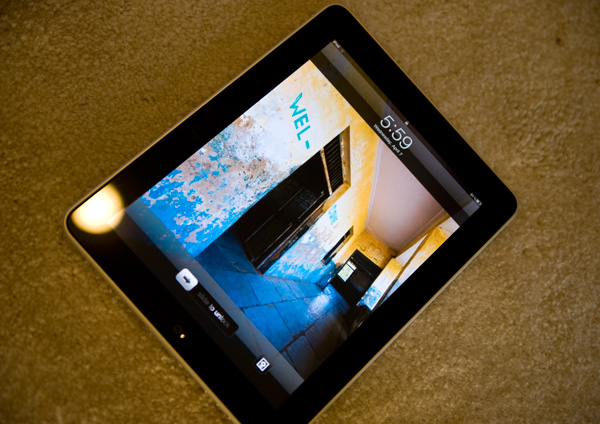
The aspect ratio actually works very well. You can comfortably view web pages in both portrait and landscape mode and get a reasonable amount of content on the screen without scrolling. Thanks to the great touchscreen, you almost want to scroll whenever possible.

iPad and iPhone side by side
The problem with using the Nexus One for the past few weeks is that going to Apple's IPS (in-plane switching) LCD in the iPad just isn't that impressive. The colors aren't nearly as vibrant or panel nearly as contrasty as the AMOLED in the Nexus One. For an LCD, it looks great, it just lacks the punch of an OLED (as well as the pricetag such a large OLED display would carry).
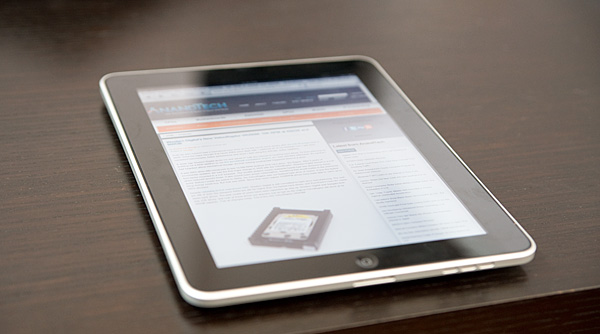
You quickly realize why Apple went with an expensive IPS panel for the iPad - viewing angle. When you're typing on the iPad it'll either be resting on a desk or angled slightly towards you. The iPad's display ensures that regardless of viewing angle, the display never looks washed out. In practice, the display performance was stellar for a device of this form factor - the viewing angle really does seem to be close to the advertise 178 degrees. There's little performance falloff or distortion even viewed at the most extreme angles. It's far more critical in an iPad than in a notebook simply because there are valid use cases where the display is totally flat. Apple spent money in the right place here, it usually does.
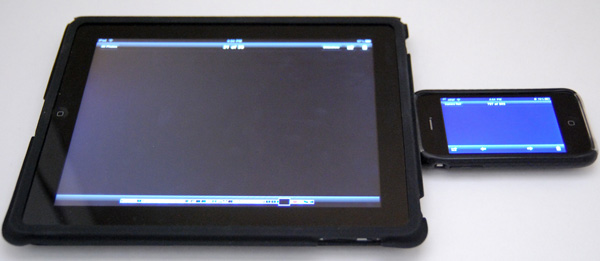
iPad vs. iPhone 3GS
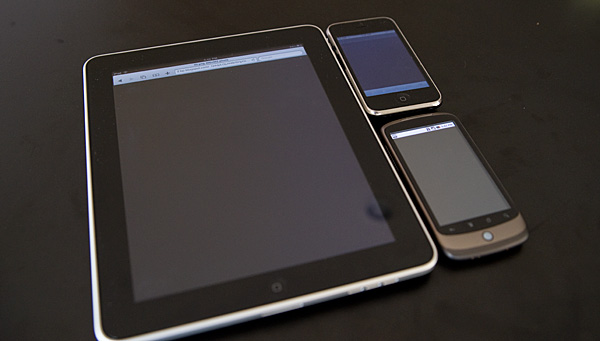
iPad vs. iPhone 3GS vs. Nexus One
In addition to viewing angle, IPS promises a larger color gamut and better contrast ratio compared to cheaper and more common LCD technologies. Qualitatively, the iPad goes far brighter than you'd need it to, and thankfully very low as well - a welcome feature for when you're reading in bed and don't want to distract. Indoors, the display is everything Apple promises, and it's clear side by side that blacks are far better on the iPad than on the iPhone. Brightness across the display is very uniform, and on the whole everything just looks great - indoors.
Indoors, the black levels between the iPad and iPhone 3GS are like night and day. In fact, several times while taking photos I thought the iPad's display had gone to sleep while displaying my black test image. It's that good. By comparison, the iPhone looks almost blue even when viewed at normal incidence.
Let's take it outside. Here's a bright sunny North Carolina day:

I stood in the sun and tried to use the iPad:
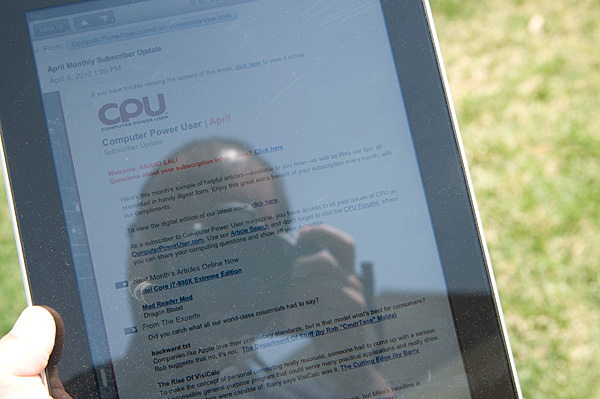
High contrast work scenarios where you're focusing primarily on black text atop a white background, like reading books, checking email, or reading the web, are definitely usable and readable outside. This is a testament to the brightness of the LCD panel. However, if you're using a particularly dark application, it's much harder to see anything comfortably.
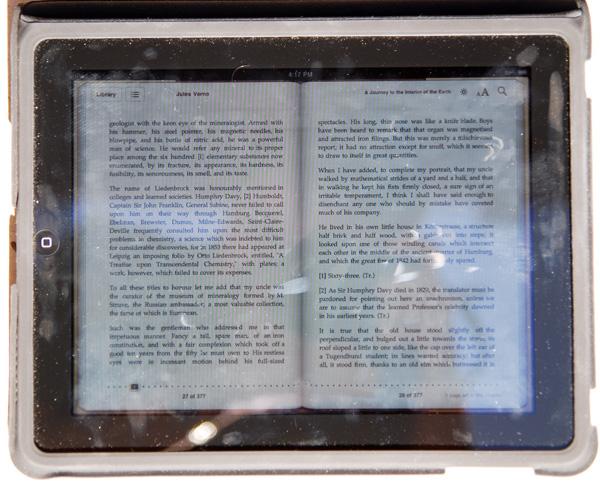
Finger prints in direct sunlight
In addition, the iPad's glassy surface doesn't have an oleophobic coating like the iPhone 3GS shipped with; the display is a fingerprint magnet. Just like the older iPhones, it always looks like you just finished eating a bag of cheetos right before you hand your iPad to anyone. Update: Apparently we're wrong and the iPad does have an oleophobic coat on it like the 3GS. Perhaps it's a different coating technique, or more likely that fingerprints are just more visible on the much larger screen.
Its glassy visage is also very reflective, as expected, and that can be distracting at times. Honestly, this is the kind of scenario where an anti-reflective coating can drastically reduce glare. There are really two scenarios to consider outside - under direct illumination from the sun, and shaded performance. Outdoors performance can be either just acceptable or perfectly miserable.

Safari in direct sunlight
After a hours of use (without eating any greasy food, I promise), in direct sunlight the iPad can get very difficult to read from all the fingerprints. However, performance in the shade outside is quite legible.
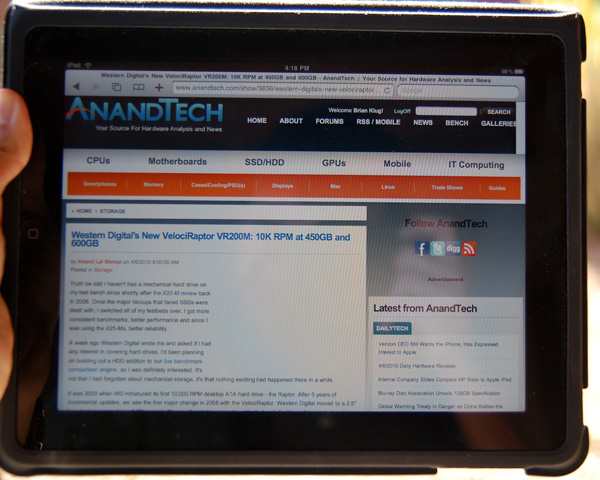
Safari outside in the shade
Clearly, the usage target Apple had in mind for the iPad was indoors, where its display is almost flawless.
But we weren't satisfied with making nebulous claims about the display performance, so we set out to verify them. After scratching our heads for a while, we settled on a shamelessly intuitive method - remote desktop. Using our X-Rite Eye-One Display 2, ColorEyes Display Pro, and some patience, we were able to measure and characterize the iPad's IPS display like any other.
Clearly, the IPS panel in the iPad offers drastically improved contrast and black levels - it's very obvious even in normal use that it blows away the iPhone.
| Display Comparison | Black Level (nits) | White Level (nits) | Contrast Ratio |
| Apple iPhone 3GS (100% Brightness) | 2.5 | 469.2 | 187.7 |
| Apple iPad (100% Brightness) | 0.4 | 373.7 | 934.3 |
| Apple iPad (50% Brightness) | 0.2 | 149.7 | 748.5 |
We also measured and were able to get color gamut volumes and uncalibrated Delta-E performance as well. However, we're not entirely convinced that these numbers are sound. The remote desktop software common to the iPad and iPhone 3GS we used offered 24 bit color depth at maximum, and the test results for both the iPhone 3GS and iPad turned out very similar. We're talking down to 0.01 Delta-E in some cases. For that reason, we're excluding the data we've obtained for color tracking until we're positive the numbers are right. Of course, the iPad itself remains 24-bit color, same as in previous versions of iPhone OS.
On the other hand, it's entirely possible that this is just the case, and color performance is the same between the two. In fact, an IPS panel was probably chosen in this context due to the very real viewing angle requirements for a handheld display of this size - anything else would be distracting. We're going to continue to investigate.
Whatever the numbers say, the display is beautiful in use and blows away most others. It's brilliant in use as a photo frame, for movies, reading books, and surfing the web. I watched a movie on it, spent a few hours reading online and a copy of HG-Wells' War of the Worlds and didn't experience any eye strain, though I'll admit I don't experience any fatigue with most LCDs. If you have a definite preference for E-Ink displays, you'll probably find reading less comfortable, but the added benefit of being able to browse the web and do everything else makes it a relatively minor trade-off. On the upside, you're reading on something that's backlit, so you don't need a book light for nighttime reading.
It's refreshing to finally see Apple taking mobile computing displays seriously with an IPS panel, instead of opting for far lower quality TN panels. Let's hope this same decision to not sacrifice display quality carries over to iPhone 4G.
Of course, the multitouch aspect of the display will be familiar to anyone who has used an iPhone or recent smartphone. We tested the iPad using all ten fingers, and they all registered properly. Even on the larger screen, using all 10 fingers is as clumsy as it is stupid looking, but clearly the iPad's screen is at least 10 point capacitive multitouch.










108 Comments
View All Comments
TGressus - Thursday, April 8, 2010 - link
"I don't think anything anyone can write can convince you"That's a tough sell right there :( Nothing against your post.
This is the challenge all tablets have faced so far. That said, if anyone has the ability to succeed in this form factor it's the iCult.
Mike1111 - Thursday, April 8, 2010 - link
"While I realize that Atom hasn't been suited for such an application until now, there's no reason Apple should've picked the A4 over Moorestown. "I really think it was the right decision for Apple to go with ARM for the iPad, and that it's the right decision to stick with ARM for at least the next few years.
(1) Mobile version of Moorestown is not available yet, the netbook one draws too much power
(2) Apple has to use ARM in it's iPhone and iPod touch for the next few years, so for cross-device OS, app and SoC compatibility and development ARM was the right choice for the iPad (e.g. if Apple makes safari use the hardware better on the iPad, the iPhone and iPod touch will directly profit from it too)
(3) Moorestown would have been more expensive
(4) With ARM Apple can control and modify the CPU design as needed, they have total control. And Apple likes that.
(5a) There is a clear upgrade path for ARM with the Cortex-A9 and a multi-core version of it.
(5b) The A4 is already fast enough for most people and most iPad tasks (how many reviews mention that the iPad is unpleasantly slow, even for the average consumer?)
It's a real possibility that an iPad with a more optimized OS and safari, a better utilized (and more programmable) GPU (like the SGX545 with OpenCL etc.) and a dual-core Cortex-A9 @1.x GHz will improve the browsing performance beyond that of a netbook. And IF APPLE SAW THE NEED FOR IT (but I don't think they do), it could happen as early as next year (other ARM SoCs like Tegra2, OMAP4 and the dual-core Snapdragon will be available by then with comparable specs, so Apple should be able to pull it off too). Intel's Atom will still be a more power consuming, more expensive and way bigger multi-chip system early next year. And beyond that are ARM quad-core CPUs and dual-core GPUs...
It will take Atom at least 4 years to overtake ARM, in the areas that count for dedicated smartphones/slates/tablets, if at all. At some point, real life browsing will just be fast enough on an ARM slate and Intel netbook, so that 99% don't care about browsing speed as a feature anymore (like it will happen with video thanks to all these powerful but small dedicated decoders/encoders like IMG's VXD/VXE).
softdrinkviking - Thursday, April 8, 2010 - link
are you saying that there is no clear upgrade path for intel's moorstown line?and that apple has complete control over the future of ARM?
i didn't know they had already gone that far.
i seem to remember apple fumbling out of the power series of CPUs and crawling into into intel's arms when they realized it was the way to go.
there is nothing to prevent apple from switching to moorstown in a couple of generations, and they have proven that they are willing to make those kind of changes when the situation demands it.
Mike1111 - Friday, April 9, 2010 - link
"are you saying that there is no clear upgrade path for intel's moorstown line?"Of course not. I'm just saying that even if you think the ARM Cortex-A8 used in the iPad is not powerful enough, that there are clear CPU upgrades coming your way for years to come (higher frequencies, Cortex-A9, dual-core Cortex-A9, quad-core Cortex-A9). It's not like Apple is using a quad-core Cortex-A9 @ 4 GHz in 22nm right now, with no better ARM architecture on the horizon and standard lithography reaching a dead end...
"and that apple has complete control over the future of ARM? i didn't know they had already gone that far."
Sorry, what I meant was that Apple has complete control over how they implement the ARMv7 architecture in a chip (since Apple has most likely an architecture license like Qualcomm).
"there is nothing to prevent apple from switching to moorstown in a couple of generations, and they have proven that they are willing to make those kind of changes when the situation demands it."
I agree that Apple can and most likely will switch to Intel if their chips are clearly superior in all the ways that matter for a mobile product. I just think that's at least 4-5 years out for retail devices so there's no point in talking about how Apple should have used Moorestown for this year's iPad... or any iPad for that matter. I don't even think that Moorestown's successor will be ready (Medfield). Maybe Medfield's successor's successor in 22nm will be clearly superior (although parity could be reached a generation earlier). We'll see.
MadAd - Thursday, April 8, 2010 - link
Its huge. Way too big for car centre consoles. If they cut it in half, so its mid way between that and an Iphone then I would definitely want to upgrade my existing car PC.Its got all the right airs and graces to be a super satnav/speedcam/music/incar wifi unit, just need to cut the size and sell it with some kind of some kind of quick release device for power and cabling (or ill fabricate one) and its a winner.
teng029 - Thursday, April 8, 2010 - link
"Companies like Crestron and AMX supply ridiculously poor touch screen interfaces to their very expensive home automation installations."How exactly did you come to this conclusion? Have you extensively either used or program a control system touch panel?
Anand Lal Shimpi - Thursday, April 8, 2010 - link
Used, but not programmed. Those touchscreen controllers are just not in the same league in terms of UI as the iPad/iPhone honestly. I haven't used the latest incarnations but from the looks of them, they haven't changed tremendously.Take care,
Anand
athreya - Thursday, April 8, 2010 - link
1. Does writepad (phatware) or sketchbook pro (autodesk) allow one to take handwritten notes on the ipad? As in, im not looking for handwriting conversion to pages or word but can notes be taken and emailed across in the body of say a gmail or a Mail message? WHich stylus is the best for the ipad?2. How do you think iphone os 4.0 will solve the multitasking problem?
3. Between the wireless keyboard and the keyboard with dock which would you recommend and why? Will ANY BT keyboard work with the ipad?
4. Can you tell us how good it is at projecting powerpoint ppts onto a standard VGA projector? Does it support Office for Mac yet?
thanks a lot Anand. Terrific balanced review as always.
strikeback03 - Friday, April 9, 2010 - link
I doubt any stylus works with the iPad, due to the capacitive screen.dagamer34 - Friday, April 9, 2010 - link
A capacitive stylus would work.